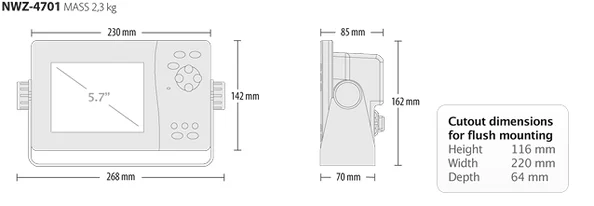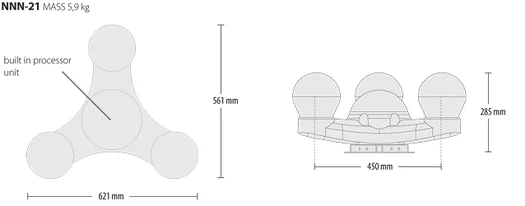Home > JRC 제품 > Navigation > GPS compass > JLR-21/31
Features
The JLR-21/31 GPS compass continues the success of its predecessor, reaching a new level of performance and stability with many new features and enhancements.
This system is also known as a 3D Dynamic Sensor™, which besides giving heading information, is designed to provide highly accurate information of the ships movement in all axis.
This system is also known as a 3D Dynamic Sensor™, which besides giving heading information, is designed to provide highly accurate information of the ships movement in all axis.
Heave compensation
The JLR-21/31 has heave functionality built-in as standard. In rough ocean conditions (with high waves), the GPS compass can correct up and down (attitude), movement. This is especially useful for fish finders and sonars on fishing vessels where high waves are compensated for with up to 20 cm accuracy, providing better potential for a profitable catch.
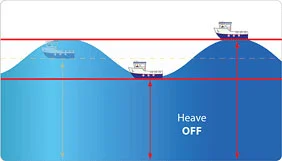

High speed update
JLR-21/31 supports Speed Over Ground (SOG) and Course Over Ground (COG). The position, SOG and COG are updated every 200 milliseconds (which is 5 times faster than previous model JLR-20), delivering high accuracy.

JLR-21/31 and IMO recommendations
Traditionally, the means used to measure the heading of a ship has been a mechanical gyrocompass and/or a traditional magnetic compass. With the adoption of the new installation requirements in SOLAS-V, all passenger ships and all ships from 300 to 500 GT travelling international routes can now install a new technology directional sensor, the Transmitting Heading Device (THD).
JRC's new JLR-31/JLR-21, IMO type-approved as both Transmitting Heading Device (THD) and as Satellite Navigator (GPS), suits for the vessels as SOLAS-V required primary heading sensor or primary GPS.
JRC's new JLR-31/JLR-21, IMO type-approved as both Transmitting Heading Device (THD) and as Satellite Navigator (GPS), suits for the vessels as SOLAS-V required primary heading sensor or primary GPS.
| IMO performance standard | Gross Tonnage |
|---|---|
| Transmitting Heading Device (THD) | From 300GT to less than 500GT |
| Satellite Navigator (GPS) | 20GT or more |
| GPS compass | Gyro compass | Magnetic compass | |
|---|---|---|---|
| Periodic maintenance | No | Yes | Yes |
| Setting time | typically 30 seconds | about 4 hours | no |
| Tracking response | High speed | Middle speed | Low speed |
| Accuracy | Good | Good | Bad |
| Magnetis influence | No | No | Yes |
| Correction | No | Yes for latitude |
Yes for variation, deviation |
OPERATION
Display modes
The JLR-31/JLR-21 incorporates many display modes readily available on a highly visible 5.7 inch LCD display. The display is fully dimmable and the keys are also backlit, making it easy to operate in low-light settings on the bridge.
Simple operation
The compact design of the JLR-31/JLR-21 incorporates an intuitive interface, providing enhanced ergonomics and user friendliness. The logic of the controls and excellent on-screen menus will greatly shorten most users' learning period.
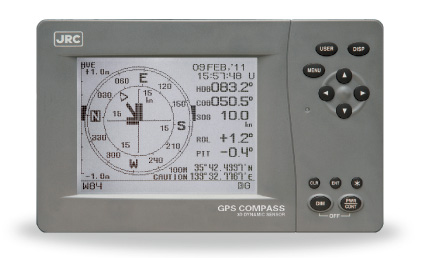
Measuring tool
The GPS compass allows calculation of distance and bearing between any two points, supporting Rhumb Lines (RL) for the short legs and Great Circle (GC) for long distance legs. Also, a trip log function comes standard for distance and heading.
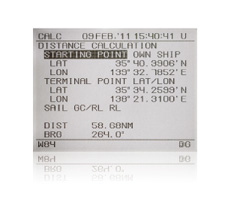
CCRP & Anchor watch
The JLR-21/31 has CCRP function incorporated, allowing the transfer of CCRP sentences to other onboard equipment and anchor watch alerts the watch officer of possible anchor dragging situations.
1. Consistent Common Reference Point
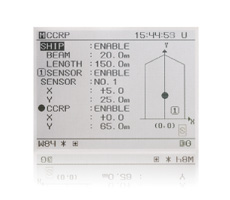
Trend graph
The new trend graph display mode shows a history of roll, pitch and heave and SOG as an easy-to-read graphical view. Selections can be made to show maximum or average results.
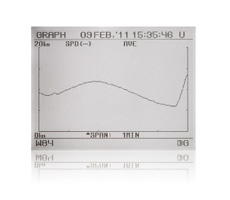
Antenna design
The processor is built into the antenna. Eliminating alignment between antenna and processor found in separate systems, therefore contributing to an easy setup with less error and significantly reduced installation time. This concept also reduces the installation costs as only a single cable is used between antenna and display unit.
The outer shell of JRC’s new antenna system has a smooth surface. This slippery exterior makes it almost impossible for birds to perch on the domes or for the antennas to be completely covered in snow.
Should something interfere with the coverage, JRC’s proven antenna design incorporates a layer of air that reduces possible blind spots, allowing for a more precise heading than conventional systems.
The outer shell of JRC’s new antenna system has a smooth surface. This slippery exterior makes it almost impossible for birds to perch on the domes or for the antennas to be completely covered in snow.
Should something interfere with the coverage, JRC’s proven antenna design incorporates a layer of air that reduces possible blind spots, allowing for a more precise heading than conventional systems.
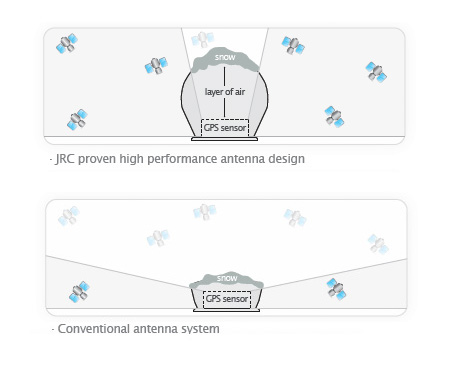
High speed tracking
The GPS compass has its origins as a direction sensing system, but the JLR-21/31 goes far beyond that. The JLR-21 provides heading accuracy of 0.5° and the JLR-31 has an impressive 0.25° heading accuracy. Heave accuracy is 20 cm or better and roll and pitch for both models is 0.5°. The tracking Rate of Turn (ROT) is 45° per second.
On the left a comparison between previous GPS compass model (JLR-20/30) and the new model (JLR-21/31).
On the left a comparison between previous GPS compass model (JLR-20/30) and the new model (JLR-21/31).
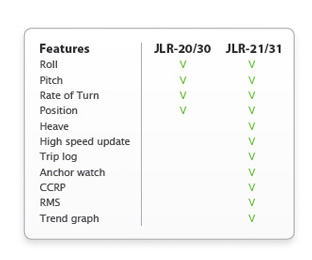
System
Interfaces
The new GPS compass integrates 5 independent working NMEA output ports, which allows for connection to a wide range of onboard navigation equipment, such as radar, plotter, autopilot, sonar or other navigation devices.
Installation and maintenance
The JLR-21/31 display is compactly designed and can be mounted virtually anywhere. The three-antenna system is exclusively designed by JRC, making it far more reliable than conventional antenna systems. The system has a short start-up time (less than 2 minutes). Maintenance is not required, making it less expensive to maintain than a standard gyro system.
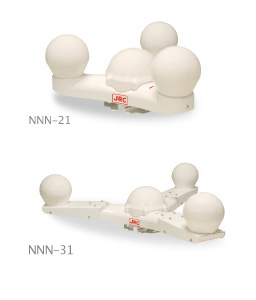
Remote Maintenance System (RMS)
JRC has the ability to cost-effectively monitor performance and functionality of the JLR-21/31 while at sea, significantly reducing downtime and maintenance costs.



